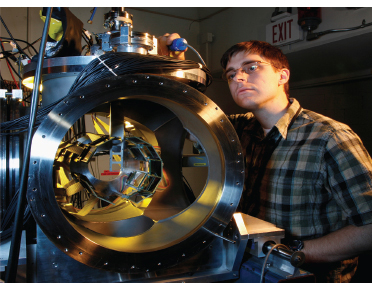
Dr Patrick O’Malley
PhD Thesis, Rutgers University (May 2012)
Understanding the origin of elements in the universe is one of the main goals of nuclear science and astrophysics today. Achieving this goal involves determining how the elements and their isotopes formed and being able to predict their abundances. At the Holifield Radioactive Ion Beam Facility (HRIBF) at Oak Ridge National Laboratory (ORNL), an experimental program has been established to use transfer reactions (such as (p,d) or (d,p)) to study the properties of many nuclei important to understanding the origins of various elements. Three measurements were done to aid in the determination of the origins of different light isotopes.
Big Bang Nucleosynthesis calculations, constrained by the Wilkinson Microwave Anisotropy Probe results, produce primordial 7Li abundances almost a factor of four larger than those extrapolated from observations. Since primordial 7Li is believed to be mostly produced by the beta decay of 7Be, one proposed solution to this discrepancy is a resonant enhancement of the 7Be(d,p)2a reaction rate through the 5/2+ 16.7-MeV state in 9B. The 2H(7Be,d)7Be reaction was used to search for such a resonance; none was observed. An upper limit on the width of the proposed resonance was deduced.
19F is believed to have formed in Asymptotic Giant Branch stars, but current models cannot reproduce the observed abundances of this nucleus. One of the key reactions responsible for the creation of 19F is 15N(a,n). Therefore, it is important to understand reactions that might destroy 15N, such as 15N(n,g). The magnitude of the 15N(n,g) reaction rate depends directly on the neutron spectroscopic factors of low-lying 16N levels. Currently the measured spectroscopic factors differ from those expected from theory by a factor of 2. A study has been done to resolve this discrepancy using the d(15N,p) reaction. The spectroscopic factors were all found to be close to unity which is in agreement with theoretical prediction
In novae, gamma ray emission is believed to be primarily due to electron-positron annihilation, though the source of these positrons remains a mystery. The positrons are believed to originate from the beta decay of 18F due to its long half-life (t1/2 ~ 110 min.). To date, gamma rays from this nucleus have not been observed. Therefore, studies have been made on reactions believed to destroy 18F, such as 18F(p,a) which goes through states in 19Ne. A recent study by Adekola et al. showed that a state at 6.289-MeV in 19Ne, just below the proton threshold, could have a significant impact on this reaction rate. However, the spin of this state could not be determined. To determine the spin of this sub-threshold state, a study of the 20Ne(p,d) reaction was made using a proton beam on a carbon foil implanted with 20Ne. Due target contaminants, a spin assignment could not
be made, but a new experimental design was created and is described in this dissertation.


